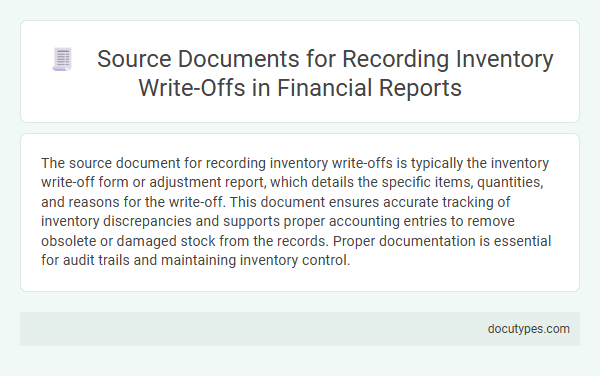The source document for recording inventory write-offs is typically the inventory write-off form or adjustment report, which details the specific items, quantities, and reasons for the write-off. This document ensures accurate tracking of inventory discrepancies and supports proper accounting entries to remove obsolete or damaged stock from the records. Proper documentation is essential for audit trails and maintaining inventory control.
Introduction to Inventory Write-Offs
Inventory write-offs occur when items in stock lose value or become unsellable, necessitating their removal from financial records. Proper documentation of these transactions ensures accurate accounting and inventory management.
- Inventory Write-Off Definition - It involves reducing the recorded value of inventory due to damage, obsolescence, theft, or errors.
- Source Document Role - Source documents provide verifiable evidence supporting the inventory adjustment made in accounting records.
- Common Source Documents - Typical documents include inventory write-off forms, internal memos, and approval signatures required for audit trails.
Importance of Source Documents in Inventory Accounting
The source document for recording inventory write-offs is typically a write-off authorization form or inventory adjustment report. These documents provide a verified record that supports the removal of obsolete, damaged, or lost inventory from accounting records. You must retain these source documents to ensure accuracy and compliance in inventory accounting.
Types of Source Documents for Inventory Write-Offs
| Type of Source Document | Description | Purpose in Inventory Write-Offs |
|---|---|---|
| Write-Off Authorization Form | A formal document approved by management to authorize the removal of obsolete or damaged inventory. | Serves as official permission for the inventory write-off, ensuring accountability and compliance with internal controls. |
| Inventory Adjustment Report | A detailed report generated by the inventory management system that records discrepancies between physical stock and book inventory. | Provides evidence of the quantity and value of inventory items to be written off due to loss, damage, or expiration. |
| Damage or Spoilage Report | Documentation prepared by warehouse or quality control teams outlining damaged, spoiled, or expired inventory items. | Supports the rationale for inventory write-off by detailing the condition and reason for write-off. |
| Inventory Reconciliation Statement | A summary report reconciling physical inventory counts with accounting records after adjustments. | Ensures accuracy of financial statements by reflecting inventory write-offs and justifying adjustments. |
| Internal Memo or Email Approval | Official communication from authorized personnel approving the write-off transaction. | Documents managerial consent and maintains an audit trail for inventory write-offs. |
| Disposal Certificate | A certificate confirming the proper disposal or destruction of written-off inventory items. | Verifies that the write-off inventory has been physically removed from storage, supporting regulatory compliance. |
Understanding these types of source documents helps you maintain accurate records and ensures transparency in recording inventory write-offs.
Inventory Adjustment Memos
The source document for recording inventory write-offs is typically the Inventory Adjustment Memo. This document provides detailed information about inventory decreases due to damage, loss, or obsolescence.
Inventory Adjustment Memos serve as official records authorized by management to update stock levels and reflect accurate inventory valuation. You can use these memos to ensure proper accounting and maintain audit trails during inventory write-offs.
Obsolescence and Damage Reports
The source document for recording inventory write-offs is primarily the Obsolescence and Damage Report. This report details items that are no longer usable due to obsolescence or physical damage.
Obsolescence and Damage Reports provide essential data for accurately adjusting inventory records and financial statements. Your accounting team relies on these reports to validate the write-off entries.
Internal Approval Forms for Write-Offs
What is the source document for recording inventory write-offs? Internal approval forms for write-offs serve as the primary source document, ensuring that each write-off is authorized and documented properly. These forms provide detailed information about the inventory items being written off, the reason for the write-off, and managerial approval, which supports accurate record-keeping and audit trails.
Supporting Invoices and Supplier Correspondence
The source document for recording inventory write-offs primarily includes supporting invoices and supplier correspondence. These documents provide essential evidence for tracking inventory adjustments and validating financial records.
- Supporting Invoices - These invoices detail the original purchase prices and quantities of inventory items, serving as proof of cost basis for write-off calculations.
- Supplier Correspondence - Communication with suppliers, such as emails or letters, documents claims, approvals, or agreements related to defective or damaged inventory write-offs.
- Audit Trail - Combining invoices and supplier correspondence creates a clear audit trail that supports accuracy and compliance in inventory write-off reporting.
Audit Trails and Documentation Standards
The source document for recording inventory write-offs is typically the inventory write-off authorization form or adjustment report. These documents provide a detailed audit trail, showing the reason for the write-off, approval signatures, and the quantity and value of inventory removed. Maintaining accurate documentation standards ensures traceability and compliance with financial reporting requirements during audits.
Integrating Source Documents into Financial Reports
Source documents for recording inventory write-offs provide the essential evidence needed to adjust inventory values accurately in financial reports. Integrating these documents ensures transparency and accuracy in reflecting inventory losses in accounting records.
- Inventory Write-Off Authorization - Official approval forms validate the decision to write off obsolete or damaged inventory.
- Inventory Adjustment Reports - Detailed reports document quantities and reasons for inventory reductions, supporting accurate ledger entries.
- Physical Inventory Count Sheets - Records from physical stock counts verify discrepancies between recorded and actual inventory levels.
Proper integration of source documents strengthens the integrity of financial statements by providing verifiable data for inventory write-offs.
What Is the Source Document for Recording Inventory Write-Offs? Infographic

